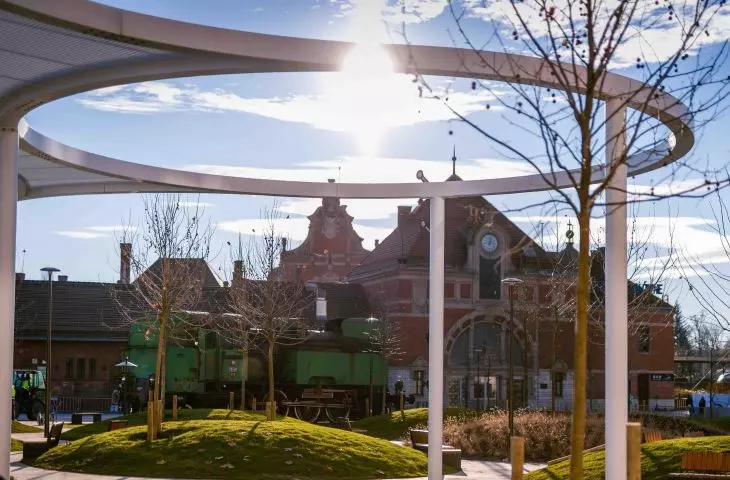The space of cities, which we see as soon as we leave station buildings, is sometimes our first collision with a new place - it is its calling card. After several years of trying to change the space, Opole lived to see the metamorphosis of the square in front of the station.
In 2018, SARP Opole, in cooperation with the Opole City Hall, announced a competition for the development of the square in front of the railroad station. The patron of the square, selected in a plebiscite, was Olga "Kora" Sipowicz, the legendary singer of the band Maanam. The first-prize winning design by the SN Architekci studio envisaged the creation of green enclaves in the form of circles, around which both residents and visitors to the city could stroll, relax or play in small play zones. Completed after several years, the project is expected to become a landmark of the city, although the familiarization of residents with the new space is just beginning - and it is often a multi-year process.
SN Architects' project was selected in a 2018 competition
© Photographs courtesy of the City Hall of Opole
We talk to Michal Szkudlarski of SN Architekci about the design process, the timing of the project, and the greenery in the square named after Kora
Wiktor Bochenek: The project, which won the competition, was realized after more than six years. That's quite a long period, what was the reason for it?
Michal Szkudlarski: The results of the competition were announced at the end of 2018, and the contract for the design work was signed in mid-2019. In 2020 we received a building permit. The City Council waited with the project due to the construction of the nearby Transfer Center building, as they wanted to avoid collisions and too much traffic obstruction. Eventually, work on the station square was completed in 2023.
Olga "Kora" Sipowicz, legendary singer of the band Maanam, became the station's patroness
© Photo courtesy of the Opole City Hall
Wiktor: The square in front of the station is a representative place for the city - what was the most difficult part of the design process for this establishment?
Michal: A particular design challenge was to create a space that would be a background for the dominant and characteristic buildings of the Main Post Office, the Main Railway Station, preserving the view axes from Krakowska Street and the intersection of 1 Maja Street with Kościuszki Street, and the newly emerging Transfer Center, while creating a public space with a distinctive character.
An additional challenge was to separate the main routes of daily pedestrian traffic (traffic towards Krakowska Street and towards the Transfer Center) from the large area of green space in such a way that they complemented each other.
Completed after several years, the project is expected to become a landmark of the city, although the familiarization of residents with the new space is only just beginning - and it is a very often long-term process
© Photographs courtesy of the City Hall in Opole
Wiktor: What functions has this space gained, what new things have appeared here? How did you come up with the idea to use a dozen green districts?
Michal: The local zoning plan required us to design a biologically active area of at least 40 percent of the entire square. This was the biggest challenge; you could see from the other competition entries that this posed a bit of a problem. Our idea was simple, we wanted to avoid large green areas inaccessible to users. We introduced pedestrian traffic between the greenery, hence the idea for an arrangement of geometric mounds with a schematic pattern of elevations. They form a modern urban park, providing residents with both places for relaxation, as well as a small playground, a space for the presentation of railroad monuments, or a meeting pavilion.
The architects wanted to avoid large green spaces inaccessible to users
© Photographs courtesy of the City Hall in Opole
Wiktor: How has the issue of greenery been resolved - has the amount of biologically active area changed, how many trees and shrubs have been added?
Michal: Currently, more than 40 percent of the square is green space, where more than fifty new trees have been planted, and it is their restoration to the city that is the greatest design achievement, but also the greatest joy for Opole residents and visitors to the city. The entire irrigation system for the "hills" has been designed, there is a large reservoir for rainwater under the square, which will be used to water the greenery, the shortage of water will be supplemented from the city network, and the excess will be discharged into the storm water drainage system.
Wiktor: Thank you for the interview.
The architects wanted to avoid large green areas inaccessible to users
© Photographs courtesy of the City Hall in Opole





























